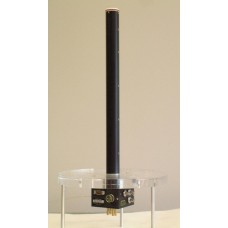Shopping Cart
0 item(s) - $0.00CapNMR DPC Probe
Add to Compare
Ask a question
Your Name:Your Email:
Your Question: Note: HTML is not translated!
Enter the code in the box below:
Protasis CapNMR Dual Flowcell Probes Cut the Effective Cost of NMR in Half
Now your NMR can do two things at once. Excellent magnetic isolation between the two detectors in the CapNMR Dual Proton Carbon (DPC) Probe allows them to be used in ‘switched’ mode with a single receiver. Most NMR spectrometers are vastly underutilized, particularly so, because significant time is required for sample (Boltzmann) relaxation between scans. Protasis uses this time ‘slack’ to multiplex your NMR and create ‘free magnet time.’ We program special pulse sequences to control a high-speed RF switch to interleave scans from Coil 2 in between scans from Coil 1. At the end of the experiment, we collate the data to present two complete NMR spectra. Computer users have grown accustomed to maintaining multiple windows and multiple applications running simultaneously. CapNMR DPC Probes bring this concept to NMR to reclaim otherwise lost acquisition time periods and nearly double your magnet utilization. Run more samples in less time with less material.
The Protasis MultiFlow DFC probes come in a variety of configurational flavors and can be tailored to your specific application needs. Presently Protasis offers the option of 5 μL and 10 μL sizes for each of the two flowcells, in the popular indirect carbon with zgradient ICG) configuration (1H/2H{13C} with z-directed gradient). Each of the independent flowcell circuits has an independent z-gradient that is controlled through the Protasis Signal Router box. Frequency lock is provided on the lower detector only, and serves to maintain both flowcells in lock with the B0 field, provided that at least a 10% deuterated solvent is utilized in the upper flowcell. We are always interested in hearing requests for novel configurations to meet new application needs.
Operational Modes
The operational modes of the Protasis DFC probe have nothing whatsoever to do with the way in which the flowcells and RF microcoils are fluidically or electrically configured. Rather, the terminology “serial” and “parallel” refer to the means in which pulse sequences interact with the two detectors.
1) Serial Mode. Illustrated below, serial mode corresponds to a condition where sample is being loaded into one flowcell while signal is being acquired from a different sample that is positioned in the other flowcell. This operating scenario may be advantageous, for example, for servicing two walk-up users for synthesis confirmation. Timing coordination is seamlessly controlled through One Minute NMR control software. For this mode of acquisition, individual shim settings are recalled (through automation) for each flowcell.
2) Parallel Mode. Parallel mode of acquisition allows signal reception from both samples simultaneously. This mode of operation is the logical choice for highthroughput laboratories where a specified sequence of experiments is run on many samples. Spectrometers that are configured with dual receivers (corresponding to the nuclei of interest) can operate the probe in true simultaneous mode for signal detection. Spectrometers equipped with a single receiver can economically incorporate the Protasis Signal Router (PSR, explained on a separate catalog sheet). This accessory works with the NMR pulse sequence and Protasis automation software to coordinate excitation and reception in a manner that results in storage of a single (parsed) file that can be deconvolved during data processing to obtain two independent signals, one from each sample. The multiplexed parallel acquisition mode is illustrated below. For
parallel mode operation, both flowcells and samples are shimmed simultaneously, i.e. using a single setting of the spectrometer shim set.
| Probe | |
| Nuclei | 1H {13C} / 2H lock |
Write a review
Your Name:Your Review: Note: HTML is not translated!
Rating: Bad Good
Enter the code in the box below:
The microNMR Outlet © 2025












